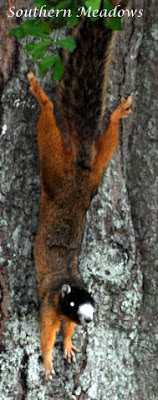A Woodland Wildflower for Early Spring
Alas, we have officially made it to spring! This winter was one of the longest and coldest in recent history here in the southeast. Although I have reveled in the quiet landscape of the winter and enjoyed our two snowfalls, I am very ready for the garden to warm up and come to life again. We've had some gorgeous, sunny, spring days teasing us of things to come; followed, by cold fronts suggesting that old man winter doesn't want to wave good-bye just yet, despite what the calendar says. Regardless, the birds have begun their serenading rituals, the frogs are calling for mates and the spring blooms are beginning to appear.
One of my favorite spring flowers that shows up in our woodland garden is bloodroot. At first look, the name bloodroot seems inappropriate for such a beautiful, snow-white flower but it gets its name from the red-orange sap found in its roots and stem. If you cut open the stem the sap will bleed out and stain everything it touches. Native Americans used it as a dye for baskets and clothing, decorating weapons and when mixed with fat, as war paint (hence the name Indian paint).
You can't miss these bright blooms as they begin to peak out of the leaf litter. Their large petals and colorful anthers attract small bees and flies. But the bloom is a trickster. It doesn't actually contain any nectar so while the bees and flies desperately search for sugar they inadvertently transfer pollen but in the end they don't get a reward for all their effort. You think they would learn! Often bloodroot is out before bees are even around so like many ephemerals, they can self pollinate by ejecting pollen from their sacs in an attempt to hit the stigma of another plant. Its a little like my boys with their slingshots; but, the more practice they have presumably the better they get.
Once the bees and flies are done with the blooms the ants take over. Through a symbiotic relationship referred to as myrmecochory (myrmeco: "ants" and -chory: "dispersal") the ants collect the seeds which have a fleshy organ called elaiosome. The ants take the mature seeds to their nest and eat the elaiosome and put the remaining seeds in their nest debris where it stays protected until germination time. Now, isn't that cool!
Bloodroot is just getting established in my garden. And, it does have its challenges ahead. If the deer don't feed on them in early spring my dogs are sure to step on them when they are racing through the woodland garden. Training them to stay on the paths has not been easy.
What is your favorite bloom that says spring has arrived?
I am joining Gail over at Clay and Limestone for Wildflower Wednesday. Do jump over there and take a look at more beautiful posts that celebrate our wonderful wildflowers.
Also, be sure to check out my friend Beth's write up on bloodroot. She has more gorgeous photos and information at Plant Postings.
One of my favorite spring flowers that shows up in our woodland garden is bloodroot. At first look, the name bloodroot seems inappropriate for such a beautiful, snow-white flower but it gets its name from the red-orange sap found in its roots and stem. If you cut open the stem the sap will bleed out and stain everything it touches. Native Americans used it as a dye for baskets and clothing, decorating weapons and when mixed with fat, as war paint (hence the name Indian paint).
You can't miss these bright blooms as they begin to peak out of the leaf litter. Their large petals and colorful anthers attract small bees and flies. But the bloom is a trickster. It doesn't actually contain any nectar so while the bees and flies desperately search for sugar they inadvertently transfer pollen but in the end they don't get a reward for all their effort. You think they would learn! Often bloodroot is out before bees are even around so like many ephemerals, they can self pollinate by ejecting pollen from their sacs in an attempt to hit the stigma of another plant. Its a little like my boys with their slingshots; but, the more practice they have presumably the better they get.
Once the bees and flies are done with the blooms the ants take over. Through a symbiotic relationship referred to as myrmecochory (myrmeco: "ants" and -chory: "dispersal") the ants collect the seeds which have a fleshy organ called elaiosome. The ants take the mature seeds to their nest and eat the elaiosome and put the remaining seeds in their nest debris where it stays protected until germination time. Now, isn't that cool!
Bloodroot is just getting established in my garden. And, it does have its challenges ahead. If the deer don't feed on them in early spring my dogs are sure to step on them when they are racing through the woodland garden. Training them to stay on the paths has not been easy.
What is your favorite bloom that says spring has arrived?
I am joining Gail over at Clay and Limestone for Wildflower Wednesday. Do jump over there and take a look at more beautiful posts that celebrate our wonderful wildflowers.
Also, be sure to check out my friend Beth's write up on bloodroot. She has more gorgeous photos and information at Plant Postings.



.png)
